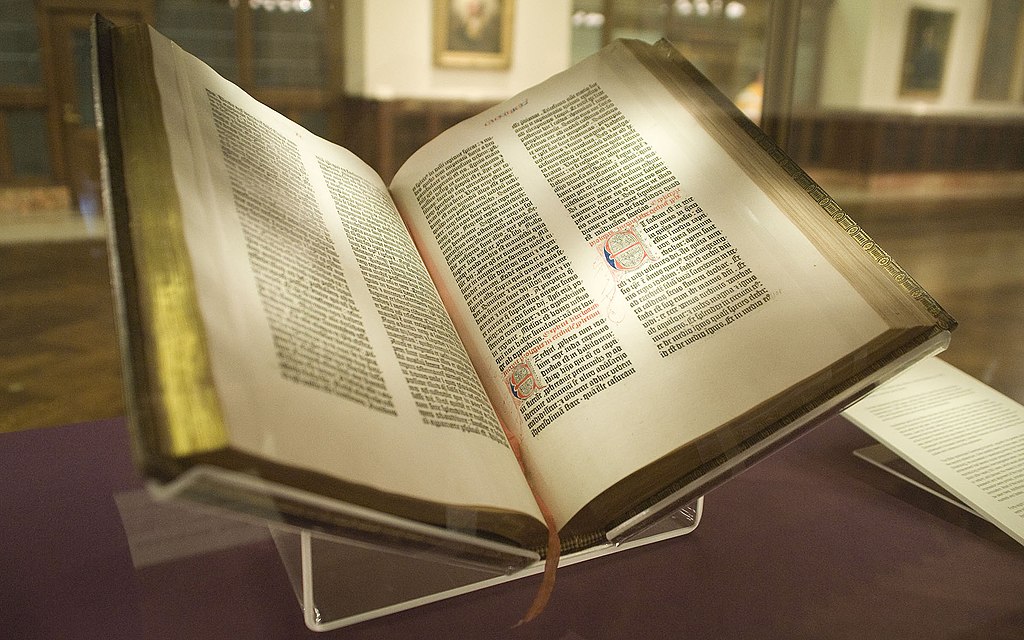Gutenberg Bible
The Gutenberg Bible (also known as the 42-line Bible, the Mazarin Bible or the B42) was the earliest major book printed using mass-produced movable metal type in Europe. It marked the start of the "Gutenberg Revolution" and the age of printed books in the West. The book is valued and revered for its high aesthetic and artistic qualities as well as its historical significance.
It is an edition of the Latin Vulgate printed in the 1450s by Johannes Gutenberg in Mainz, in present-day Germany. Forty-nine copies (or substantial portions of copies) have survived. They are thought to be among the world's most valuable books, although no complete copy has been sold since 1978. In March 1455, the future Pope Pius II wrote that he had seen pages from the Gutenberg Bible displayed in Frankfurt to promote the edition, and that either 158 or 180 copies had been printed (he cited sources for both numbers).
Text
The Gutenberg Bible, an edition of the Vulgate, contains the Latin version of the Hebrew Old Testament and the Greek New Testament. It is mainly the work of Jerome who began his work on the translation in 380 AD, with emendations from the Parisian Bible tradition.
Printing history
Preparation of the Bible probably began soon after 1450, and the first finished copies were available in 1454 or 1455. It is not known exactly how long the Bible took to print. The first precisely datable printing is Gutenberg's 31-line Indulgence which is known to already exist on 22 October 1454. Gutenberg made three significant changes during the printing process. The first sheets were rubricated by being passed twice through the printing press, using black and then red ink. This was soon abandoned, with spaces being left for rubrication to be added by hand.
The most reliable information about the Bible's date comes from a letter. In March 1455, the future Pope Pius II wrote that he had seen pages from the Gutenberg Bible, being displayed to promote the edition, in Frankfurt. It is not known how many copies were printed, with the 1455 letter citing sources for both 158 and 180 copies. Scholars today think that examination of surviving copies suggests that somewhere between 160 and 185 copies were printed, with about three-quarters on paper and the others on vellum.
The production process: Das Werk der Bücher
In a legal paper, written after completion of the Bible, Johannes Gutenberg refers to the process as Das Werk der Bücher ("the work of the books"). He had introduced the printing press to Europe and created the technology to make printing with movable types finally efficient enough for the mass production of entire books to be feasible.
Many book-lovers have commented on the high standards achieved in the production of the Gutenberg Bible, some describing it as one of the most beautiful books ever printed. The quality of both the ink and other materials and the printing itself have been noted.
Early owners
The Bible seems to have sold out immediately, with initial sales to owners as far away as England and possibly Sweden and Hungary. At least some copies are known to have sold for 30 florins, about three years' wages for a clerk. Although this made them significantly cheaper than manuscript Bibles, most students, priests or other people of ordinary income wouldn't have been able to afford them. It is assumed that most were sold to monasteries, universities and particularly wealthy individuals.
At present only one copy is known to have been privately owned in the fifteenth century. Some are known to have been used for communal readings in monastery refectories; others may have been for display rather than use, and a few were certainly used for study.[page needed] Kristian Jensen suggests that many copies were bought by wealthy and pious laypeople for donation to religious institutions.
Influence on later Bibles
The Gutenberg Bible had a profound effect on the history of the printed book. Textually, it also had an influence on future editions of the Bible. It provided the model for several later editions, including the 36 Line Bible, Mentelin's Latin Bible, and the first and third Eggestein Bibles. The third Eggestein Bible was set from the copy of the Gutenberg Bible now in Cambridge University Library. The Gutenberg Bible also had an influence on the Clementine edition of the Vulgate commissioned by the Papacy in the late sixteenth century.
Locations of known complete Gutenberg Bibles
As of 2009, 49 Gutenberg Bibles are known to exist, but of these only 21 are complete. Others have pages or even whole volumes missing. In addition, there are a substantial number of fragments, some as small as individual leaves, which are likely to represent about another 16 copies. Many of these fragments have survived because they were used as part of the binding of later books. 12 copies on vellum survive, although only four of these are complete and one is of the New Testament only.
